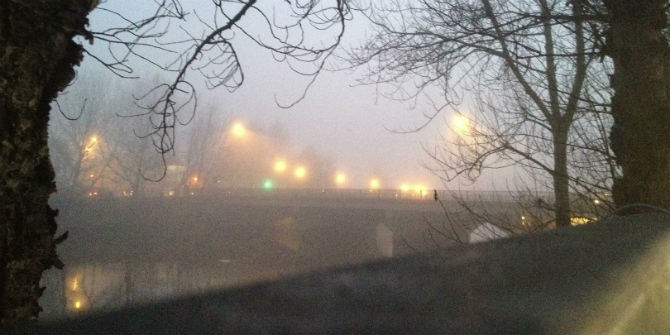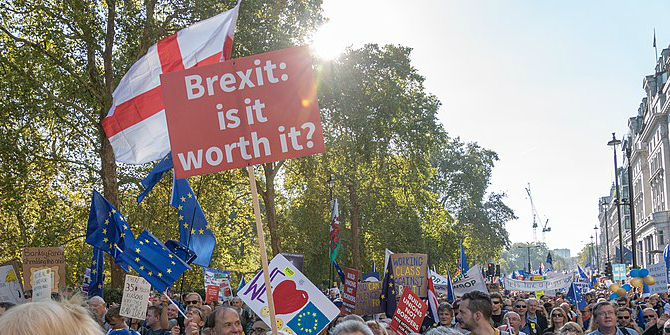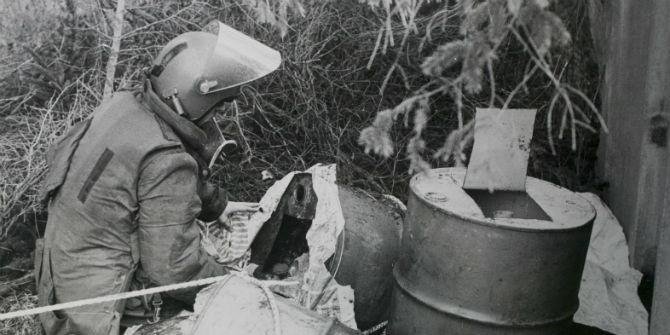It took a long time to realise what the Brexit vote would mean for Northern Ireland, writes Duncan Morrow (Ulster University). Even now, a thickening intellectual and political fog still surrounds its future.
Give or take a Derry/Londonderry, Belfast is the most constitutionally-battered city in the United Kingdom. Storm ‘History’ – with its endless warning that the enemy will be merciless in victory, and promise that our victory will secure paradise – still blows every day along its peace walls, murals and still-isolated city centre. Some parts of the city are more open air museum than modern economy.

Of course, identity is everything precisely because it is so vulnerable . Ferocity is the sound of anxiety, not confidence. And fear in Belfast has too often seemed existential, and is still visible. The centenary of Northern Ireland will mark a hundred years of constant contention, with no assured victory. Yet so few minds have changed. Endless displays of exaggerated Britishness have converted no nationalists, and countless songs of freedom have won no Unionist hearts.
Instead, contention itself became the ‘golden thread’ marking Northern Ireland’s distinctive ‘culture’. Conflict was never a battlefield event in Belfast, more its way of life. A hundred years of uneasiness is what has given the city its flavour and made it so ‘foreign’ to the rest of both Britain and Ireland.
For twenty years, we have hardly known what to make of peace, and certainly not known what to make with it. With our enemies now our partners and our fight with them officially over, we have not quite worked out who we were or how we should ‘be’ with each other. Peace was our foreign country. So we never really moved there. At best, it was a kind of second home: nice to have and to show off to visitors.
But at least it was respite. The Agreement gave protection from the storm – for a while. Though the quarrel remained, at least the violence abated. By 2007, both governments concluded that this was the best that could be achieved. Reconciliation was left for another day, though nobody admitted it. Once the world financial crash set in, new governments concluded that containment would have to do.
Containment, by definition, limits but does not eliminate what it contains. The Agreement’s ramparts were power-sharing between two previously implacable enemies in Belfast, guaranteed by a fail-safe outer wall of British and Irish government determination. When hostilities overwhelmed the locals again, the governments would make arrangements to put the system back in place.
Until Brexit. With Northern Ireland behind its safety wall and Ireland neatly separated from ‘Europe’ in the English mind, the failure to foresee the implications of a harder UK-EU frontier for the Irish bunker was almost inevitable. Focused as ever on their local struggle, few inside the Northern Ireland container saw it coming. It took a while to internalise the fact that Brexit meant the return of the border to everyday politics. Only afterwards did it dawn on politicians that containment by the Agreement was constructed on truly exceptional inter-state co-operation, which was now being destroyed by English anti-Europeanism. The Agreement had been broken not by an explosion in its core, but by a crack in its outer wall.
When the inner system failed again in 2017, what would previously have been ‘a local difficulty’ was primed to become a systemic crisis. In response, the best that anyone could offer was unstable stasis – for three years. In the meantime, active politics left Belfast. At Westminster, Northern Ireland’s Unionists seemed to have cast their lot with England’s Brexiter cavalry to seek the hardest possible deal. With only one MP present and voting, the Northern Irish anti-Brexit majority – nationalist, unionist and other – found itself represented by the Irish foreign minister and Michel Barnier of the Commission, in a perverse version of ‘everything about us, without us’. One thing it did not feel like was ‘taking back control’. When Boris Johnson agreed to ‘a customs border in the Irish Sea’ on the Wirral a week before the deadline, even Unionism’s most vocal critics were shocked by the brutal speed with which their loyalty was repaid by a Conservative government.
The UK general election in December only reinforced the strategic chaos. For the third time in a year, voters in Northern Ireland reaffirmed the 60-40 split against Brexit and shifted their votes decisively to the centre, just as England voted to pull up the drawbridge. Belfast was strangely united in the perception that the UK had lost its way, if for diametrically opposite reasons. But the electorate did not seem convinced that a United Ireland provided any obvious path forward. So though Unionism won fewer Westminster seats than Nationalism for the first time in a hundred years, the big winners were the ‘don’t knows’ and the ‘don’t trust the simple answers’.
And the election was only the beginning. The unusually activist Secretary of State, Julian Smith, moved swiftly with the Irish government to close a new deal on devolution within weeks. Not that either got any thanks for their efforts: by mid-February Smith had been removed from post, apparently for insubordination, by a rampant Johnson and the Irish government had been decisively defeated in a general election which saw Sinn Fein returned as the largest party in the state. Paradoxically, their success was almost entirely due to a campaign focussed on exclusively southern issues. But nobody thought that it would be without implications for the fragile balances in Belfast.
Exactly what has happened to either the Good Friday Agreement or Brexit – or what would happen to the border and when – remained shrouded in a thickening intellectual and political fog. High-flown commitments to upholding the Agreement to ensure unfettered market access for NI business rolled easily off the tongue. But it was increasingly difficult to pin down substance. In the meantime, Belfast does what it does best in a crisis: it puts one foot in front of the other and gets on with what remains. The ship is still afloat, but it is becoming increasingly difficult to know precisely where we are. And there are rumours of more storms.
This post represents the views of the author and not those of the Brexit blog, nor LSE.







As aspect I wonder about is whether the possibility of SF in power in the Republic is good or bad for the possibility of unification.
I suspect bad…but SF might at least be in a position to “force” the UK to call for a border poll if they had strong leverage during the trade negotiations.
Mind you, the reason I suspect that the overall effect is bad is that I cannot imagine moderate Unionists being happy about the prospect of a united Ireland run by SF.
Thoughts?